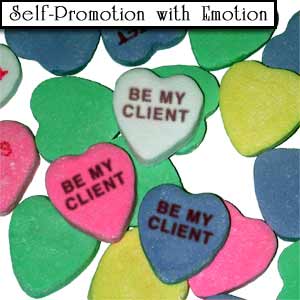 |
|
||||||||||||
|
Columns by Linda Formichelli:
List all of Linda's columns
Visit our other Getting Work columnist
|
You came up with ten crisp, indisputable reasons your prospect should hire you over the competition. Your proposal was flawless, and the creases in your borrowed suit were so sharp they could have sliced cheddar. So why did your prospect go and hire someone else? It could be that although you had honed yourself into a tool of blinding perfection, you failed to appeal to that warm and mushy side of the prospect -- the one that likes puppies and long walks on the beach. "Decision-makers rationalize their decisions with logic, yet they buy… with emotion," says Jeff Blackman, author of Peak Your Profits. This isn't new. Marketers have always appealed to the emotions, but until recently, they were appealing to fear and greed -- those black, ugly emotions that fester within the soul. "Buy my design services so your clients won't leave you and your boss won't fire you and your wife won't sleep with your best friend," they'd say. "Hire me for your next project and you'll get more hotties, wads of money, and cartons of Bazooka gum than you can shake a stick at." Fear and greed. Now, though, marketers are starting to look at that tactic the way voters are starting to look at the Electoral College -- as an antiquated notion that doesn't quite work. Marketers have finally started to realize -- duh -- that people don't actually like feeling scared and hoggish. The startling revelation that people would rather buy things that make them feel good than bad is just starting to sink in, so heed this advice now and you'll be so far ahead of the curve that you and the curve won't be able to see one another. While your competitors are pouring their energies into giving prospects the heebie-jeebies, you'll be drawing them to you by making them feel all warm and gooey inside. Giving the Goo "So what are these positive emotions I'm supposed to be appealing to?" you ask impatiently, stamping your feet like a little girl and foaming at the mouth. Well, what makes you feel good? Love. Trust. Respect. Nice things like that. "So how do I use these emotions to sell my services?" you screech, flapping your arms as your eyes roll back into your head in a most unbecoming fashion. Take a tip from Saab, the Swedish auto manufacturer, on how to sell to your prospects' better sides: According to Blackman, Saab once ran two full-page ads side by side in business magazines. The left-hand page had "21 Logical Reasons to Buy a Saab," such as four-valve technology, advanced ergonomics, and a special steel underpanel. This page was printed in black and white. The headline of the right-hand page had just three words: "One Emotional Reason." Beneath this headline was a color picture of a Saab Turbo whirring through the countryside. "Talk about a powerful impact!" says Blackman. "The ad not only delivered the features, but it then showed what the Saab driving experience means emotionally." There's one problem here: Saab has been around a heck of a lot longer than the average IP, and has earned the trust and respect of their customers. (And they've got a mountain of marketing dough.) You, on the other hand, need to earn those treasured feelings. "You need to give prospects the feeling that they like you, that you care about them, that you have their best interests at heart -- these are the emotions businesses play to today," says Jack Burke, author of Creating Customer Connections. Giving It All Away According to Burke, traditional cold calls and sales letters lead to icy emotions. Melt your prospects' hearts by solving their problems instead. As an example, Burke cites an insurance firm in Tacoma that wanted to go after the fleet-truck market. Instead of calling prospects with a self-aggrandizing spiel or sending a letter filled with superlatives, the company asked members of the fleet-truck industry what their most pressing problems were. The company then found top experts in these fields to make audio tapes addressing these problems, and sent the tapes to their target market. So instead of scaring prospects with visions of bankruptcy and lawsuits, the insurance company fostered all sorts of mushy feelings in them. "This developed long-term emotional warmth instead of short-term emotional need," says Burke. Okay, so maybe you don't have the scratch to manufacture and mail thousands of audio tapes. Instead, try sending out a newsletter chock full of tips that help your prospects make money, save time, or solve a problem. A Web designer, for example, could send out a list of the top Web-design faux pas (that's French for "screwups"). An accountant might include reviews of personal-finance software. Words Worth Prospects don't give a hoot about your scads of awards and your advanced degrees in graphic design. They care about what you can do for them and how you can make them feel good. That's why "you" is the magic word when it comes to inflaming your prospects' desires. In other words, your marketing materials should be light on the "I" and "we" and heavy on the "you." If you want to get your prospects all fuzzied up, avoid words and phrases that will make them feel like they stumbled into a marketing conference. For example, "we will provide" becomes "we'll give you" or "you'll get." "Aid" becomes "help," "receive" becomes "get," and "We'll synergize your paradigms" becomes "We'll help you work more effectively." Feel Their Pain Another way to get emotional with your prospects is to feel their pain. Like the things they like. Hate the things they hate. When Lena West, president & CEO of the marketing firm xynoMedia Development, was trying to land a contract with an organizational-change company, she had to play it just right. Says West: "I appealed to the non-traditional side of their corporate culture by agreeing to video and telephone conferences in lieu of face-to-face meetings. I also took the liberty of doing some initial work off-the-clock to show them what I was capable of and that I really wanted their business." She even joked around with and took a considerably lighter demeanor than she would have taken with a stiffer client. West also did her homework so she would be able to mirror the prospects' feelings. The company was into this grass-roots organizational change message, so West read up on the styles of organizational change that they didn't like. During conversations with them, she would casually mention why she didn't like so-and-so's agenda, or what a crock she thought so-and-so's message was. "It was akin to fitting into a cult -- well, not really, but you know what I mean," says West. "I had to adopt their mindset -- even if momentarily -- to get this deal on the table." It worked. "I appeared to be more interested in the 'message' than I was in getting the gig," says West. So take this advice to heart: Fill your prospects with warm and soft emotions, and you'll be filling your pockets with cold hard cash. |
|
|
We'd love to hear your feedback about this column, or put you in touch with Linda Formichelli if you like. You may also like to see her biography. |
The 1099 name and logo are trademarks of 1099 Magazine.

